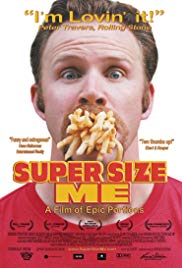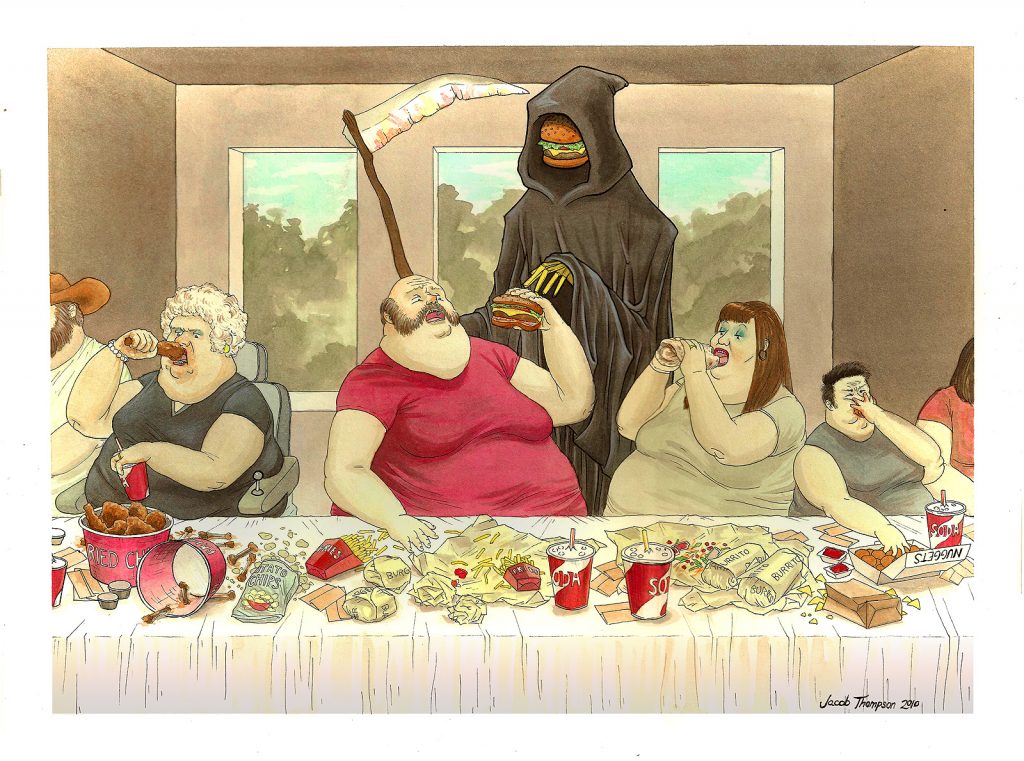Select the questions suitable for your class. For this assignment in word processing format, see Super Size Me Homework Assignment. Note that the assignment assumes that the lecture or an equivalent has been given to the class or that students have read the Student Handout. The homework assignment can also be given to the class as an open book test.
1. List four different types of convenience foods.
2. What is a common definition of obesity? Give your answer in terms of the percentage of a person’s weight that is comprised of fat.
3. List the three most important causes of preventable death for the entire population in the U.S. Then list the three most important causes of preventable death among U.S. teenagers.
4. In terms of BMI, what is a healthy weight, what is overweight, and what is obesity?
5. State in words the formula for BMI and describe what it measures. Be sure to include a reference to pounds and inches in your statement. Then calculate your own BMI.
6. For the most current year for which we have statistics on how many children were obese, state the year, the number of children in the U.S. who were obese and their percentage of the population of children.
7. Name ten serious diseases that obese people get more often than people who are not obese.
8. Why are people in the U.S. getting fatter? Mr. Spurlock told us. What did he say?
9. What percentage of meals do Americans eat in restaurants, including fast food outlets?
10. Explain the psychology behind supersizing. Why is it a good marketing technique?
11. If a person is presented at a meal with more food than he or she could possibly eat, how much more food will the average person consume than he or she needs? Give your answer in terms of a percentage.
12. What is the profit margin for French fries sold in fast food restaurants?
13. Why do restaurateurs like to sell super-sized meals?
14. What does “ersatz” mean?
15. Give two examples of specific convenience foods that are ersatz food that we learned about in this unit. Describe why they are called ersatz.
16. What are the four general types of foods that can hurt our health if we are not careful to consume moderate or small amounts?
17. What is a flavorologist?
18. What is the difference between natural and artificial flavors put into foods?
19. Food additives are tested for safety, so why are they still a risk to our health? Give two reasons.
20. Fats and salt often make food taste better. Why do we like the tastes of fats and salt?
21. What are trans fats and why are they bad for us?
22. What is the mechanism by which LDL cholesterol causes heart disease?
23. Which types of fats do not contribute to heart disease?
24. What types of foods contain fats that have high amounts of LDL cholesterol?
25. What types of foods contain fats that do not contribute to cholesterol found?
26. Why does advertising affect young children more than it does teenagers and adults?
27. The Food and Drug Administration says that our diets should contain between 5 and 20% fat. What do some nutritionists say about the 20% number?
28. What is the “nag factor”?
29. What doesn’t sugar have that is healthy for us?
30. How did the growth of the sugar industry in the 17th and 18th centuries contribute to the Industrial Revolution? How did the growth of the sugar industry contribute to the slave trade?
31. Remember Jared Fogel, the young man who lost so much weight eating at Subway? What were the two most important reasons for the success of his weight loss program? Did they have anything to do with the fact that he ate at Subway?
32. In the study that followed 50,000 nurses, how many cans of soft drinks a day did it take to lead to weight gain and an 80% increase in Type 2 Diabetes?
33. In 2005, how many pounds of sweetener did the average American consume? How much of this amount was sugar and how much was HFCS?
34. When the World Health Organization stated that it was going to release a recommendation that sweeteners account for only 10% of daily calories, what did the food industry do?
35. The caloric content of the largest serving of McDonald’s French fries that you can buy has changed from 1960 to the present. Describe that change.
36. What is the recommended caloric intake per day for teenagers?
37. People with Type 2 diabetes are at risk for several other illnesses. Name three of them.
38. Can you rely on the nutrition statistics on the websites of the convenience food companies?
39. Did Mr. Spurlock’s 30-day fast food diet have any effects on his mind? What were they?
40. Name four things that society as a whole could do to reduce the obesity epidemic. (Don’t list things that an individual can do, but only list what society as a whole can do.)
41. Assignments, Projects, and Activities for Use With Any Film that is a Work of Fiction.
42. Separate the class into groups. Assign or allow each group to chose a position on one of the questions below. Give each group two weeks to do research on the Internet and in the library. Then stage debates in class on the following propositions:
- Eating meat should be discouraged for our health, to help save the environment, and to stop the torture and slaughter of billions of innocent animals each year.
- Advertisements of convenience food aimed at children under 15 years of age should be prohibited.
- Advertisements of convenience food should contain a clear statement of the dangers of the food to the health of the consumer.
- Fastfood like McDonald’s or pizza should not be served for lunch at high schools.
- Sodas and sugared drinks should not be available to students from vending machines at school.
Have the students who hear the debates write a short essay describing their position any of the issues debated.
43. Have students cook and eat a vegan meal or call a local vegan restaurant and ask the chef to give a talk to the class and bring some food.
44. Send students to different fast food restaurants to ask to see information about the ingredients, calories and nutritional content of the food. They should report back about what they were told and what they found out.
45. Have everyone in the class perform an inventory of what they eat in a typical day and then examine it in relation to what we have learned about what not to eat.
46. Class members can interview one another and make a plan to eat better.
47. List on the board or in a handout a number of famous people that the class would be interested in who are also vegetarian.
48. Students can research and report on the backgrounds of the top five officers in the Department of Agriculture from the Secretary down the chain of command to those who head the departments dealing with nutrition. See if they have any ties to companies which might sway their decisions about nutrition.
49. Have students investigate and report to the class whether the food industry or its executives make substantial donations to various charitable organizations which give advice on health and nutrition and whether the contributions affect the advice given by the charitable organization.
50. Have students go to a movie theater or a fast food restaurant and compare the “value” between an extra large serving and the next smallest serving of different foods.
See also, Additional Assignments for Use With any Film that is a Work of Fiction and Lesson Plans Using Film Adaptations of Novels, Short Stories or Plays.







